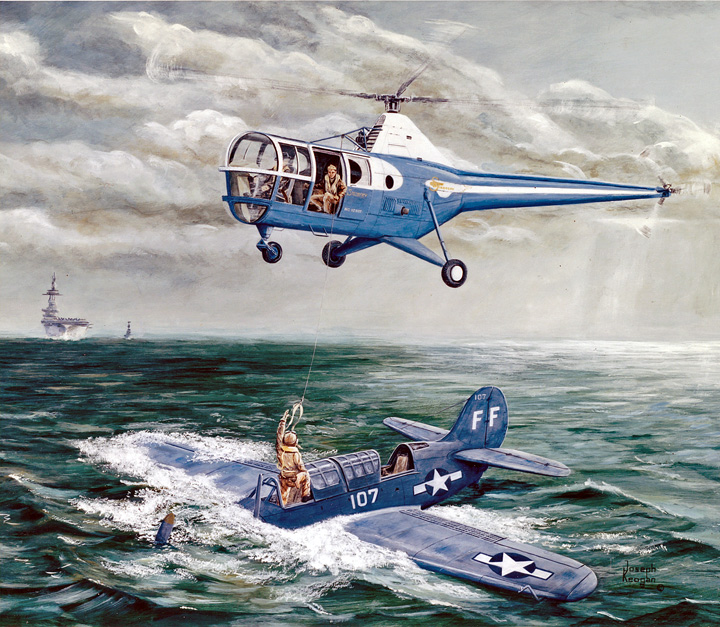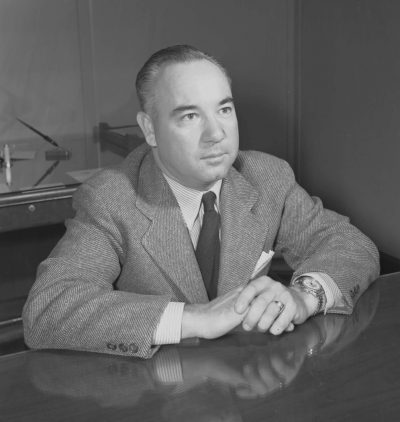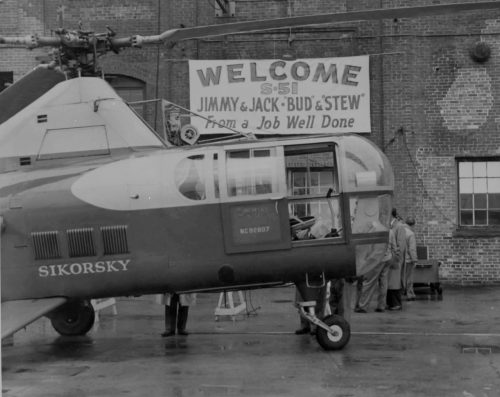Sikorsky Aviation History
The World’s First Helicopter Naval Rescue
February 9, 1947
Lieutenant Shields reporting aboard, sir. I wish to report an accident…………………….
“What d’ya mean you’re Lieutenant Shields?” snapped the flight control officer without even bothering to look up. “Shields just had an accident. His plane was forced down. He’s in the water right now.” Casually, be glanced up-and then did a “double take”. For, wonder of wonders, the bedraggled young flier standing there was Lieutenant Robert A. Shields.
But how had he done it? Scarcely six or seven minutes before Shields had radioed he was ditching his SB2C because of engine failure. He’d ditched it, too, by the looks of his soaked flying suit. But, here he was, big as life, back aboard his carrier, the Leyte, when by all odds he should have been bobbing about in a life raft waiting to be picked up by a tin can and returned to the carrier later in the day, or maybe the next day.

The flight control officer shook his head. “Hell,” he muttered, “this man’s navy is getting too fast for me.”
The answer to Shields’ speedy return was a Sikorsky S-51 helicopter flown by D. D. (Jimmy) Viner, chief test pilot for Sikorsky Aircraft. Viner, based with Task Fleet 2 to demonstrate the capabilities of the rotary-winged aircraft, had just picked up Shields and the latter’s crewman, Aviation Radioman Don K. Little. The date was February 9 and it was the first of four rescues made by the helicopter during the fleet’s recently completed maneuvers in the Atlantic and Caribbean.
Operating from the big carrier, Franklin D. Roosevelt, the helicopter, in the eyes of hundreds of officers and seamen, proved beyond doubt its usefulness to the fleet not only for rescue work but for many other duties which it performed more speedily and efficiently than they had ever been done before.

On his first day at sea, Viner picked up and delivered ship-to-ship correspondence – “guard mail” in navy jargon – covering a dozen vessels in thirty-five minutes. Ordinarily, the “guard mail” keeps a destroyer busy from sun-up to sun-down. Carrying the mail became routine for the helicopter as the cruise progressed.
A few days later Viner flew a fleet’s senior surgeon over to the Randolph in time for an emergency operation on a young crewman. Countless hours were saved during the maneuvers by ship-to-ship and ship-to-shore helicopter shuttles. The forward gun turret of the battleship Missouri made a perfectly adequate helicopter landing field.
Once, Viner transferred a submarine commander from the FDR to the submarine Greenfish which had surfaced nearby – the first time such an aerial transfer had ever been made. When the FDR left Norfolk, Va., at the start of the cruise, the harbor pilot was flown ashore by helicopter, completing in a few minutes an operation usually requiring a couple of hours.
But the rescues made naval aviation history and drew most of the attention. One flier escaped death by a split second thanks to swift, skillful handling of the helicopter. It happened on February 18, southeast of Bermuda.
Viner and Lieutenant Joe Rullo, a naval aviator assigned as observer on all the helicopter flights, were whirling along not far aft of the FDR. This was their customary position on what is called “plane guard”. They were keeping a close watch on the launching and recovery of the carrier’s planes.
Several SB2C dive-bombers were landing. Suddenly, one plane spun out of a turn at low altitude. Even before the craft struck the water, Viner nosed the S-51 down and plummeted toward the impending crash. The SB2C splashed and sank immediately.
Pulling up over the crash site, Viner and Rullo saw no sign of life. Then the pilot, Lieutenant Commander George R. Stablein, bobbed to the surface. The crewman, August J. Rinella, perished in the accident, either knocked out by the impact or unable to free himself from the smashed airplane.
Badly hurt and unable to inflate his life jacket, Stablein went down twice and was sinking a third time as Viner guided the helicopter right down to the water. Rullo lowered his hoist cable directly into the drowning man’s hands. Stablein clutched frantically at the cable, grabbed it and hung on.
Viner lifted the S-51 clear of the waves as Rullo used the hydraulic hoist to haul the 230-pound Stablein up alongside the helicopter’s open door. Stablein, too dazed to fasten a rescue belt harness, with which the cable was fitted, still clung by his hands. At the top of the hoist his fingers were pinched by the pulley wheel and he released his grip. But split-second teamwork by Rullo and Viner saved the day. Rullo threw his arm around the falling man and Viner, at that instant, tilted the helicopter sharply to the right. The result: Stablein toppled into the helicopter instead of back into the water.
Back aboard the FDR, Viner and Rullo suddenly realized how low they’d flown. Water was pouring from the helicopter’s nose wheel pylon, evidence enough that the nose wheel had actually been under the surface. It was an unbeatable example of precision flying and a most convincing demonstration of the helicopter’s rescue capabilities. A few minutes later, from Vice-Admiral William H. P. Blandy aboard the flagship Missouri, came the rarely-given commendation, “Very well done”.
In contrast, the helicopter’s third and fourth rescues were routine affairs. Picked up from their life raft on the morning of March 3, Lieutenant (jg) W. J. Forgy and Ensign R. Felty were safe aboard the FDR just seven minutes after setting their SB2C down in the water two miles from the carrier. The Viner-Rullo team had clicked again.
That noon, Jackson E. Beighle, a Sikorsky Aircraft pilot, who had joined the task fleet February 28 at Trinidad, needed only four minutes to carry out the rescue of Lieutenant Eugene J. Weinbeck, a Hellcat pilot.
Upon completion of the helicopter’s part in the fleet exercises, both Viner and Beighle, as well as Sikorsky crew chiefs Stewart Hill and Miles Roosevelt who also made the cruise aboard the FDR, praised the cooperation given them by Captain John P. W. Vest, and all her officers and men.
Slim, dark-haired Joe Rullo will never forget the cruise. “These last six weeks have provided the most wonderful experiences of my life,” he said. Somebody asked why. “Because I’ve been flying with Jimmy Viner,” he replied.
It’s natural to expect enthusiasm for the helicopter from such air-minded officers as Captain Vest and Lieutenant Rullo. But Rear Admiral John Wilkes, commander of the Atlantic Fleet submarine force, was every bit as glowing in his estimate of the rotary-winged craft’s place in future naval operations.
Admiral Wilkes, who witnessed the recent exercises as an observer aboard the submarine Greenfish, said the usefulness of and efficiency of the helicopter was one of the vitally important facts disclosed by the maneuvers. He said the work of the helicopter was astonishing and that the craft had “sold itself” to the fleet by the various and versatile activities which it performed throughout the exercises.
 The helicopter carried several hundred passengers during the maneuvers, among them John N. Brown, assistant secretary of navy for air; Admiral Blandy, Vice-Admiral A. W. Radford, Rear Admiral A. M. Pride, Rear Admiral John H. Cassady, Captain Vest, Captain T. B. Hill, skipper of the Missouri; Captain John L. Pratt, aide to Mr. Brown, and Sir Errol Dos Santos, governor of Trinidad.
The helicopter carried several hundred passengers during the maneuvers, among them John N. Brown, assistant secretary of navy for air; Admiral Blandy, Vice-Admiral A. W. Radford, Rear Admiral A. M. Pride, Rear Admiral John H. Cassady, Captain Vest, Captain T. B. Hill, skipper of the Missouri; Captain John L. Pratt, aide to Mr. Brown, and Sir Errol Dos Santos, governor of Trinidad.
Admiral Blandy was enthusiastic about the helicopter’s possibilities for service with the fleet. Its chief value, he believes, lies in rescue work, submarine detection and reconnaissance, light pickup and delivery operations, and passenger exchange among units at sea.
Jimmy Viner never saw as much ice cream as he did the day he left the FDR to return to the Sikorsky plant at Bridgeport. It’s an old navy custom to give the crew of a rescue ship ten gallons of ice cream. Having made three rescues, Viner and Rullo got thirty gallons. They took one look at this windfall and declared open house in the ready room. When Viner left the crew had cracked open the last ten gallons and were still going strong.
